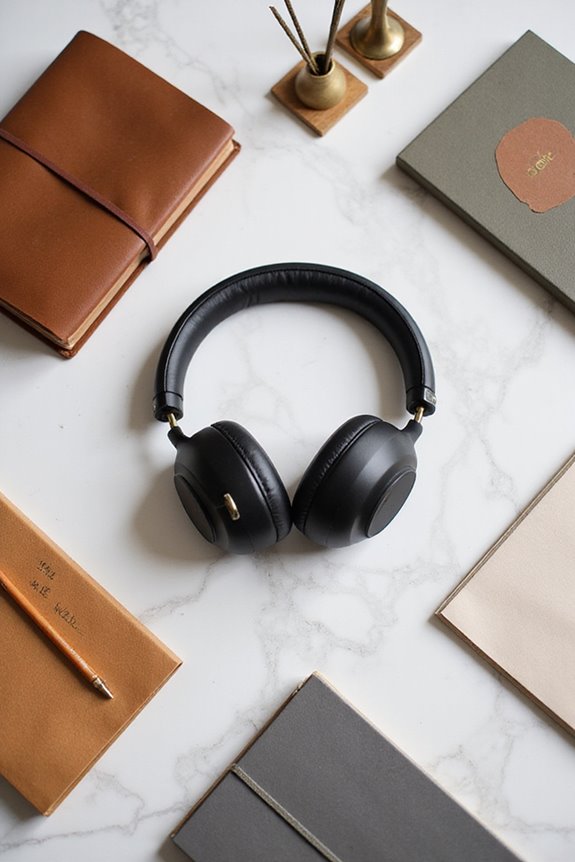Binaural music for focus uses specific sound frequencies to help our brains align with certain mental states. By listening to two different tones, one in each ear, we create a third beat that can enhance concentration and attention. For studying or tackling tough tasks, we might try gamma frequencies, around 40 Hz, to sharpen our focus. It’s like a secret weapon for our minds! Stick around, and we can explore more about how these beats can boost our productivity.
Key Takeaways
- Binaural music for focus involves listening to two different audio frequencies in each ear, with the brain creating a third tone that enhances concentration.
- Gamma-frequency binaural beats, particularly around 40 Hz, are associated with improved attentional focus and cognitive performance.
- Using binaural beats can help filter out distractions, allowing individuals to sustain concentration during tasks and study sessions.
- Consistent use of binaural music can promote a calm mental state, reducing anxiety and improving overall mood while working.
- Experimenting with different frequencies and durations can help individuals find the optimal binaural music for their specific focus needs.
Understanding Binaural Beats and Their Mechanism

When we plunge into the world of binaural beats, it helps to know how they actually work. Binaural beats occur when we hear two tones at slightly different frequencies, with each ear receiving one. Our brains then *magically* combine these sounds, creating a third “beat” that’s processed in the auditory cortex. This auditory processing is essential, as it leads to a phenomenon called neural synchronization. The superior olivary complex in our brainstem integrates these sounds, aligning our neural responses to the beat frequency. To experience binaural beats effectively, choose carrier frequencies below 1000 Hz, with a frequency difference under 35 Hz. When we’re in sync, we might find ourselves more focused, creative, or relaxed. So, let’s tune in and explore this fascinating auditory journey together!
The Role of Frequencies in Mental States

Understanding the role of frequencies in shaping our mental states is essential if we want to harness the benefits of binaural beats effectively. When we listen to two slightly different frequencies, our auditory perception creates a third tone—this is known as frequency modulation. Each frequency affects us uniquely; for example, theta frequencies can help us relax and spark creativity, while beta frequencies can enhance alertness and improve concentration. By intentionally selecting specific frequencies, we can target desired mental states. If you’re looking to unwind, try some binaural beats in the alpha range. On the other hand, for focus, beta frequencies might be your best bet. It’s all about knowing which frequencies to tune into!
Impact on Attention and Concentration

Although we might not realize it, the sounds we choose to listen to can considerably impact our attention and concentration. Binaural effects, especially with gamma-frequency beats around 40 Hz, help sharpen our focus. By listening to these binaural beats, we can experience what’s called attention modulation, allowing our brains to zoom in on tasks and filter out irrelevant information more easily. However, it’s essential to remember that not everyone responds positively; some might find their attention drifting instead. To maximize benefits, try incorporating binaural beats into your study sessions but be mindful of the frequency and duration. Experiment and observe how these audio tools fit into your routine—who knows, they might just help you ace that next test!
Cognitive and Emotional Benefits

Binaural beats can offer us a unique way to boost our cognitive capabilities and emotional well-being. By listening to these auditory tones, we can enhance our memory retention and overall cognitive flexibility. For instance, if we focus on beta frequencies, we might find improvement in our problem-solving skills. Plus, they can help us reach that meditative state quicker, promoting emotional stability that we often crave during stressful times. With consistent practice, we might notice reductions in anxiety and stronger mood regulation. So, next time you’re studying or working on a project, try integrating binaural beats into your routine. Who knows? You might just ace that test or nail that presentation while feeling calm and collected!
Scientific Evidence and Current Limitations

We’ve seen how binaural beats can boost our cognitive and emotional health, but what does the scientific world say about them? Research indicates that binaural beats, especially in the gamma frequency, may enhance our attentional focus and potentially even affect neurochemicals like dopamine. However, we have to recognize the research gaps. Most studies are short-term, often involving healthy adults, which limits our understanding of their clinical implications for kids or those with cognitive challenges. Additionally, findings aren’t consistent; while some frequencies help concentration, others might actually hinder it. So, while binaural beats show promise, the science is still catching up. We need more diverse and long-term studies to truly gauge their effectiveness in real-life scenarios.
Practical Applications and Popularity
As we look for ways to boost our focus and productivity, it’s worth exploring how binaural music has found its way into our daily routines. Many of us are turning to apps like BrainWave, where we can access 40 Hz binaural beats for enhanced focus. It’s user-friendly, making it popular among younger adults and students. In marketing trends, wellness influencers are highlighting these tunes for meditation and mood regulation, increasing their reach across various application platforms. Though effectiveness can vary—some of us may face mixed user experiences—anecdotal benefits often drive adoption. So, whether studying or just needing a mental boost, experimenting with binaural beats could be our next step to sharpen our attention!
Frequently Asked Questions
Can Binaural Beats Be Used for Sleep Improvement?
Yes, we can use binaural beats for sleep improvement! They promote relaxation techniques, support healthy sleep cycles, and help us drift into restful sleep more easily. Many of us have experienced their calming benefits firsthand.
Are There Any Side Effects of Listening to Binaural Music?
As we sail through the soundscape of binaural music, we must heed the potential risks. Individual sensitivity varies; some may find calm, while others could encounter storms of discomfort or distraction. Choose wisely, fellow travelers.
How Long Should I Listen to Binaural Beats for Effectiveness?
We’ve found that a binaural session duration of 15 to 20 minutes is ideal for effectiveness. By listening consistently, we can enhance cognitive performance and focus, adjusting our listening time based on personal responses and needs.
Can Binaural Beats Help With Anxiety Management?
Isn’t it fascinating how binaural beats can aid in anxiety reduction? We’ve seen studies showing significant drops in anxiety levels, making them a compelling tool worth exploring collectively for calming our minds during stressful moments.
Is It Safe to Use Binaural Beats While Driving?
We don’t recommend using binaural beats while driving due to potential cognitive risks. While they might provide some binaural effects, driving safety necessitates full alertness, and these tools shouldn’t replace proper rest or breaks.





